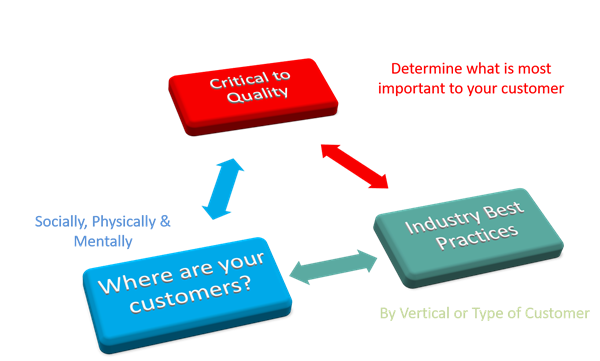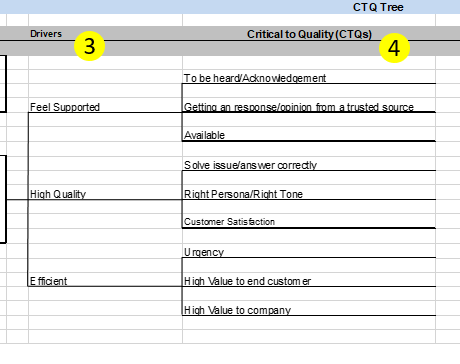By
Michael Pace
|
Date Published: March 13, 2019 - Last Updated December 03, 2019
|
Comments
When ICMI asked me to write a blog post
about customer service metrics for social media, I was excited about the
chance to discuss much of what I learned over the last ten years building
social customer service programs. I reviewed the dozen or so companies I have helped
design social customer service metrics for, and realized many of the
metrics were consistent, and some were dependent upon the industry or the customer base (B2C, B2B, B2B2C). But the process of
determining the right metrics for those companies was always the same –
using Critical to Quality
process management techniques to uncover the metrics that truly matter.
According to the Master of Project Academy,
Critical to Quality (CTQ) is defined as “the
internal critical quality parameters that relate to the wants and needs
of the customer
. The (internal and external) customer requirements get translated into
Critical-To-Quality (CTQ) features. These CTQs define the criteria to
evaluate what good looks like i.e., how well the project scope and
deliverables meet requirements. CTQ is a simple, yet powerful tool that
translates customer needs into a Meaningful, Measurable, and Actionable metrics for people
or group of people.”

How to Create a Social Customer Service CTQ Tree:
Step 1: Identify Customer(s)
The first step is the step most leaders overlook. Defining who the customer is that you are serving, who is paying for the process, and who may be
impacted is critical. For any process or metric, you need to understand your customer.
Only then you can articulate what is important (or Critical to Quality) to
your customer, where your customers are (physically, socially, mentally),
and what the rules are (written and unwritten) for your industry.

Step 2: Identify in Broad Terms what your customer needs
This step is the articulation of what your customer wants from your
process. It should be broad, but relatively simple – think
Elevator Speech. If you are not sure what your customer needs are, review posts from a
variety of networks, and seek to understand what they are looking for –
acknowledgment, frustration venting, praise, solutions, or something
completely unexpected. Make sure to understand not only what is important
to your customers, but also where your customers are (what social networks they're using,
where they're writing from – store, home, work, mobile, etc…). It is also important to understand any industry related
practices (regulated industries, compliance standards).
Step 3: Identify the Quality Drivers
The Quality Drivers are high-level descriptions of the look, feel, and actions
of the customer needs. Again, refer to your identified customers and
determine what is critical to quality for them. Your primary customer’s
needs should outweigh any other ancillary customer’s needs, but that
doesn’t mean their needs aren’t important. For example, if you built your
customers needs without any concern for what matters to your company, the
likelihood of success will be greatly diminished.
Step 4: Identify Your CTQ’s
This step defines your Quality Drivers in more detail and should be what is
Critical to Quality to your customers. For example, if you determined that a key driver is ensuring your customer “Feels Supported," what are the characteristics of a process that makes a customer “Feel
Supported?"
- To be heard/acknowledged
- Getting a response from a trusted source (is this you, or your community, or both?)
- Being available---ask yourself how available you are

Step 5: Identify the metrics that validate your Critical to Quality
drivers
FINALLY, WE HAVE ARRIVED AT THE METRICS! This is the step that validates or proves,
either quantitatively or qualitatively, that you are meeting your customer
expectations.
For example: Feel Support>To be heard/Acknowledgement>
- % of social media inquiries responded to
- How many social impressions has this post made (possible followers who
have seen, shared, or retweeted
- # of thank you’s
For each Driver and Critical to Quality, you need to determine the possible
ways for you to measure each metric. You may not have the current
capability to measure each metric today, but these are the metrics you
should be striving to track.
Final tips for social customer service metrics:
-Remember, all social networks are not the same. Each platform or tool will have
different requirements and are used for different reasons. For example,
Twitter and Facebook response expectations are very different.
- Twitter should be considered as text. If someone sends you a text, and
you respond 45 minutes later, you are not very responsive.
- Bot what you can and where you can. Facebook is an obvious choice here.
Don’t pretend it is not a bot, but leverage your knowledge bases and speed
of bots.
- Social is a fantastic place to be proactive. Send “how to messages” and alerts
in real time to provide helpful tips and transparency
- Since social is a many-to-one platform, your cost per contact should be
something to brag about to senior management
What tips would you add to the mix? Drop a comment below.